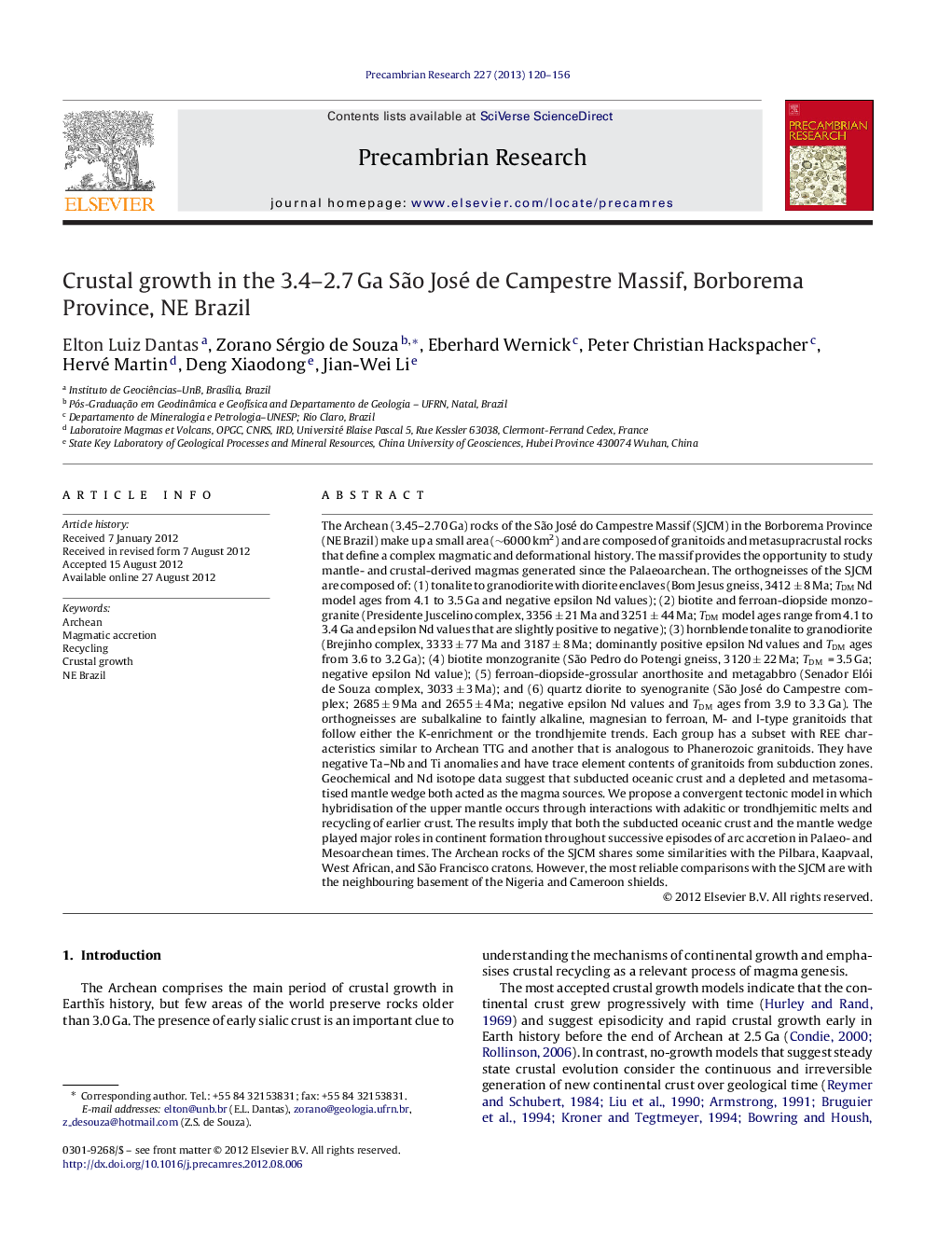| کد مقاله | کد نشریه | سال انتشار | مقاله انگلیسی | نسخه تمام متن |
|---|---|---|---|---|
| 4723398 | 1639647 | 2013 | 37 صفحه PDF | دانلود رایگان |

The Archean (3.45–2.70 Ga) rocks of the São José do Campestre Massif (SJCM) in the Borborema Province (NE Brazil) make up a small area (∼6000 km2) and are composed of granitoids and metasupracrustal rocks that define a complex magmatic and deformational history. The massif provides the opportunity to study mantle- and crustal-derived magmas generated since the Palaeoarchean. The orthogneisses of the SJCM are composed of: (1) tonalite to granodiorite with diorite enclaves (Bom Jesus gneiss, 3412 ± 8 Ma; TDM Nd model ages from 4.1 to 3.5 Ga and negative epsilon Nd values); (2) biotite and ferroan-diopside monzogranite (Presidente Juscelino complex, 3356 ± 21 Ma and 3251 ± 44 Ma; TDM model ages range from 4.1 to 3.4 Ga and epsilon Nd values that are slightly positive to negative); (3) hornblende tonalite to granodiorite (Brejinho complex, 3333 ± 77 Ma and 3187 ± 8 Ma; dominantly positive epsilon Nd values and TDM ages from 3.6 to 3.2 Ga); (4) biotite monzogranite (São Pedro do Potengi gneiss, 3120 ± 22 Ma; TDM = 3.5 Ga; negative epsilon Nd value); (5) ferroan-diopside-grossular anorthosite and metagabbro (Senador Elói de Souza complex, 3033 ± 3 Ma); and (6) quartz diorite to syenogranite (São José do Campestre complex; 2685 ± 9 Ma and 2655 ± 4 Ma; negative epsilon Nd values and TDM ages from 3.9 to 3.3 Ga). The orthogneisses are subalkaline to faintly alkaline, magnesian to ferroan, M- and I-type granitoids that follow either the K-enrichment or the trondhjemite trends. Each group has a subset with REE characteristics similar to Archean TTG and another that is analogous to Phanerozoic granitoids. They have negative Ta–Nb and Ti anomalies and have trace element contents of granitoids from subduction zones. Geochemical and Nd isotope data suggest that subducted oceanic crust and a depleted and metasomatised mantle wedge both acted as the magma sources. We propose a convergent tectonic model in which hybridisation of the upper mantle occurs through interactions with adakitic or trondhjemitic melts and recycling of earlier crust. The results imply that both the subducted oceanic crust and the mantle wedge played major roles in continent formation throughout successive episodes of arc accretion in Palaeo- and Mesoarchean times. The Archean rocks of the SJCM shares some similarities with the Pilbara, Kaapvaal, West African, and São Francisco cratons. However, the most reliable comparisons with the SJCM are with the neighbouring basement of the Nigeria and Cameroon shields..
► Available geochronological data indicate episodes of magma generation at 3.41, 3.35, 3.33, 3.25, 3.12, 3.03 and 2.70 Ga.
► Geochemistry and Nd isotopes suggest magma genesis by melting of hybridised upper mantle and Archean tholeiite crust.
► Generation of Yb-poor and Yb-rich magmas permits extending the role played by the mantle wedge back to the Palaeoachean.
Journal: Precambrian Research - Volume 227, April 2013, Pages 120–156